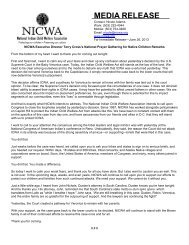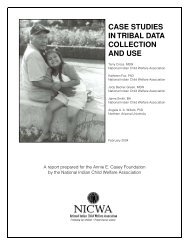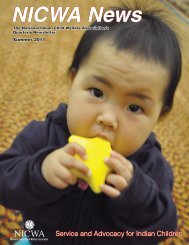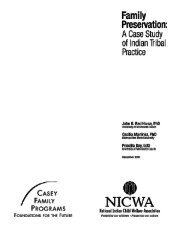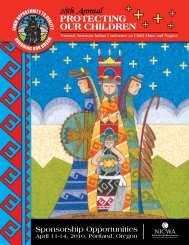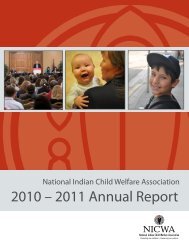Native American Children and Youth Well-Being Indicators
Native American Children and Youth Well-Being Indicators
Native American Children and Youth Well-Being Indicators
You also want an ePaper? Increase the reach of your titles
YUMPU automatically turns print PDFs into web optimized ePapers that Google loves.
eservation, is an enrolled member of the NavajoNation, <strong>and</strong> has a large extended family livingboth on <strong>and</strong> off the reservation. She has about30 years of experience as a social worker <strong>and</strong>three years of direct experience with research on<strong>Native</strong> <strong>American</strong> well-being indicators. Residingin Flagstaff, Arizona, in a “border town” communitynear the boundaries of the Navajo <strong>and</strong> HopiNations in northern Arizona, she also has knowledge<strong>and</strong> practice experience with <strong>American</strong>Indians/Alaska <strong>Native</strong>s <strong>and</strong> works as an educatorwith <strong>American</strong> Indian undergraduate <strong>and</strong> graduatesocial work students. In addition, she conductedher dissertation on the ethnic identity ofyoung Navajo women living off the reservation.As is commonly done in qualitative research, allof these personal <strong>and</strong> professional experienceswere utilized to filter the documents.Data CollectionThe selection of data that are purposeful inaddressing the research question is important.Documents such as professional articles <strong>and</strong>book chapters were selected for review; theyprovided the narrative, words, or concepts foranalysis. In qualitative research, the production of“rich description” is one of the primary goals. Thedocuments selected present the “reality” of<strong>Native</strong> <strong>American</strong> life, beliefs, values, worldviews,<strong>and</strong> cultural norms. The positive aspects ofselecting professional articles are that they arein the public domain <strong>and</strong> are free to the user. Thelanguage is accessible, <strong>and</strong> the method savesthe time <strong>and</strong> expense of transcription (Creswell,1994).Whenever possible, documents written by <strong>Native</strong><strong>American</strong> authors who are considered well-publishedscholars in their disciplines were selectedfor this review. Some of the authors were chosento indicate their own “lived-experience” of beinga <strong>Native</strong> <strong>American</strong> or having experiences in theirown tribal culture. Of course, not all of theauthors are <strong>Native</strong> <strong>American</strong>, but many havewritten <strong>and</strong> worked with <strong>Native</strong> individuals, families,groups, <strong>and</strong> communities.Two primary processes that influence qualitativeresearch are the “reduction” of data <strong>and</strong> the“interpretation” of material (Marshall & Rossman,1998, p. 114, cited in Creswell, 1994, p. 154).As Creswell (1994) stated that, “data analysisrequires that the researcher be comfortable withdeveloping categories <strong>and</strong> making comparisons<strong>and</strong> contrasts” (p. 153). Creswell (1994) statedthat “the researcher takes a voluminous amountof information <strong>and</strong> reduces it to certain patterns,categories, or themes <strong>and</strong> then interprets thisinformation by using some schema” (p. 154).This research project follows these basic tenets.The analysis process utilized in the evaluationof the documents consisted of the followingfour steps:25




